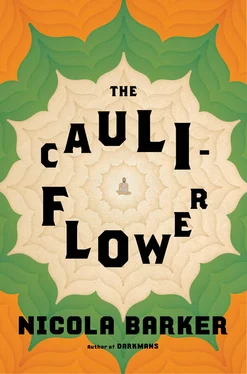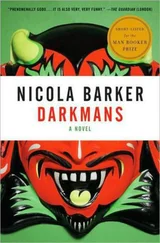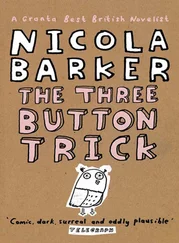Oh yes. Uncle did tell me. But was serving Uncle enough for poor Mathur Baba? Did serving Uncle so faithfully release Mathur Baba from the wretched cycle of death and rebirth?
I have learned my lesson. What other choice is there? My hands are now tied. I am bound to Uncle. I have accepted my place. I am resigned to it. So I continue to serve Uncle faithfully. But there is a shadow fallen across my heart. And there are voices that whisper to me, that taunt me — resentful voices, ambitious voices.
Sometimes I quietly ponder that conversation between Uncle and Mathur Baba, and how Mathur Baba thought Uncle was simply toying with Hridayram. How Uncle said that I would experience bliss and then return to my former self again. Uncle has many powers. I have witnessed his use of them. But why would Uncle, who loves Hridayram so dearly, use these powers to end Hridayram’s bliss? Is Uncle only being self-serving? Does Uncle not think there is room enough in the Dakshineswar Kali Temple for two paramahamsa s?
These are dark imaginings. And I must be careful of them. Because Uncle has the power to read the thoughts of others. Uncle looks into people’s minds and sees everything hidden there, as if he is idly peering at the contents of a glass case.
So I serve Uncle as dutifully as I can, although all of my former habits and simple pleasures seem dry and tiresome to me now. What is the point in anything? Mathur Baba has gone, and with him all assurance of worldly comfort and happiness.
Ah, but my life winds on. I have taken a new wife. I have earned enough money over recent years to build a new worship hall in my home village. I am still a priest at the Dakshineswar Kali Temple. I have purchased a cow. And of course there is Uncle. There is always Uncle. Oh, surely that must be enough?
Approximately twelve years later. The struggling guru asks Ma Kali why he shouldn’t be cured of his throat cancer:
“Ma, I cannot eat!”
[ the poor guru cries ]
“But you eat through all these mouths …
[ Ma Kali roundly chastises him ]
Through your disciples!”
A momentous development: 6th November 1885, at Syampukur (Sri Ramakrishna’s temporary residence in Calcutta), on the day of the Kali Puja
The Master has asked his devotees to make the necessary arrangements for the Divine Mother to be celebrated. That evening, the devotees bring numerous delightful offerings to the Master’s second-floor room. What a spread! A plethora of ripened fruits and colorful, creamy sweets and bowls of fragrant rice pudding (baked with coconut milk and cardamom and rosewater and vanilla); plates bearing sandalwood paste and vilwa leaves and burning cones of aromatic incense; mounds of flowers — especially generous quantities of Kali’s favorite giant trumpet-shaped hibiscus, with its sumptuously long yellow stamen poking and arching — quite indecently — from the midst of its gaping scarlet maw. All these are brought and respectfully presented before the beaming guru , who is smartly attired in a new wearing cloth, and has been experiencing (quite involuntarily) a heightened state of almost perpetual ecstasy throughout the entire day thus far. There are about thirty people present. The mood is joyful and harmonious.
The arati commences. But something is not quite right. There is no image of the Goddess in the room. Sri Ramakrishna sits amid the offerings and tells the devotees to sit quietly with him and to meditate for a while. Time passes. ( Aaaauuuuummmm! ) And more time passes ( Aaaauuuummmmm! ). And still more time passes ( Hmmm? ). How much time? We cannot say. Then the guru quietly turns to Girish Chandra Ghosh and murmurs, “It is the Divine Mother’s day.”
Girish — who is an artist, and emotional by nature — is suddenly overwhelmed by an inexplicable feeling (hysteria? mindless compulsion? love?) and finds himself frantically grabbing garlands of flowers and tossing them at the guru ’s feet (“I do not know what took hold of me,” he says afterwards). All the while, Girish is crying (accompanied by an equally fervent Ram Chandra Datta), “ Jai Sri Ramakrishna! Jai Sri Ramakrishna! Jai Sri Ramakrishna!”
The remaining devotees, inspired by their example, then promptly follow suit, proffering a rich abundance of other objects to their beloved guru . One devotee prostrates himself before the Master, pushing his head against his feet.
“ Jai Ma!” the devotees chant, “ Jai Ma!” (Victory to the Mother!)
Sri Ramakrishna instantly falls into a state of deep samadhi . He is facing north. He is holding his arms out as Ma Kali does in her sacred images — the fingers of one hand indicating fearlessness, the other granting boons. He seems to have no body consciousness, and his skin … ah, his legendary, golden skin … it glows .
The devotees are mesmerized by the guru . They are in awe. They are transfixed. They are speechless. After a lengthy duration, furtive glances are exchanged, throats are nervously cleared, and then they quietly commence — with hushed and reverential voices — the singing of hymns. It’s as if the Divine Mother herself is now inhabiting the guru . God is here, in this very room. She is he. He is she. They are one.
Extraordinary, eh? But let’s shift our focus, just for a moment, from these curious activities joyfully unfolding in a slightly threadbare Calcuttan sitting room, to some other places in the world (Really? There are other places?), where, that same month, the Serbian army will occupy Bulgaria, Gottlieb Daimler will present the world with his first motorcycle, Pope Leo XIII will publish an important but slightly drab encyclical entitled Immortale Dei (about the delicate balance of relations between church and state), and a meteor shower will be caught on camera for the first time.
Click!
Ten days earlier, Johannes Brahms — a composer, who, like Sri Ramakrishna, is both a traditionalist and an innovator (“Such a man, such a fine soul,” gasps Antonin Dvořák, “and he believes in nothing! He believes in nothing!”) — will premiere his final symphony, No. 4 in E Minor. He will conduct it himself, in Meiningen, central Germany, probably wearing a cheap suit, with no socks, and his giant beard shockingly unkempt. Brahms’s dear friend Hans von Bülow, on hearing the first movement of this new symphony on piano, will exclaim, “For the whole movement I had the feeling that I was being given a beating by two incredibly intelligent people.”
And so it must be this, this orchestrated beating — but what else? — that serves as the emotional soundtrack to the curiously smooth and strangely inevitable but still oddly faltering and clumsy transition of Sri Ramakrishna from man into God. We see the scene before us, once removed, through a series of tiny glass slides with added color (blotches of yellow and red and green, applied with a possibly overgenerous brush). Ah, here is the guru entering the room.… Here is a close-up of his beaming face. Here is a group of passionate devotees.… Here — goodness gracious! — the next slide … a devotee collapsed in a clumsy heap, insensible with devotion, against a wall.…
The ardent opening notes of Brahms’s passionate Fourth Symphony — the sweep of violins and the violas, the cellos — these notes, newly hatched, just born, are spinning across the stratosphere: in the next slide the devotees are pelting the Incarnation with handfuls of giant hibiscus. What rhythmic instability the Brahms is conjuring up…! How fragmented the melody! How devastating the descending sequence!.. Look at that! It’s the guru ’s feet.… Oh! And that! The curious arrangement of his golden fingers …
Читать дальше












